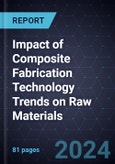Increasing Focus on Lightweighting Ensures Future Growth Potential
Composite materials are made from two or more heterogenous materials comprising of the matrix (polymer) and reinforcement (fiber). Composite materials are virtually used in every industry and are witnessing a rapid growth in demand. This is due to the increasing demand to make end products high-performance and energy-efficient.
A variety of open-mold and closed-mold fabrication techniques are used to manufacture such products. These include hand layup, spray-up, resin infusion, compression molding, injection molding, filament winding, pultrusion and prepreg, among others. The study aims to estimate the current state of fabrication technologies used across sectors and analyze how technological advancements can create growth opportunities. As the industry witnesses a growing penetration of composites in higher volume markets, the composites industry can offer opportunities for raw material manufacturers, composite manufacturers, component manufacturers as well as digital solution providers.
One of the first sectors to adopt fiber-reinforced composite was the aerospace sector, and it was subsequently adopted by the automotive, marine, energy, and construction sectors, among others. Cumulatively, these sectors account for over 70% revenue in the composites industry. The material’s high strength-to-weight ratio continues to transform the products in these sectors as OEMs switch or expand to composite alternatives.
Different fabrication techniques are suitable for different part sizes and applications. These are selected based on the desired characteristics of the end-product. Several industry-specific trends are driving the demand for specific composite products, enabling a robust use of manufacturing techniques. For instance, the increasing demand for cost-effective composite parts in the automotive industry boosts the use of compression and injection molding. Further, as the hydrogen economy gains momentum, methods such as filament winding are expected to gain traction.








